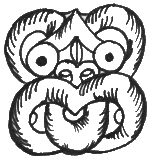 |
 |
|
|
Ladbrooks Primary School
Lake Waihora
Maori Connection
 Forest and swamp land were in the area from Christchurch to Te Waihora through to early Maori times. Te Waihora was said to be the lake with the most resources in the South Island with eels, flounder, mullet, whitebait, freshwater crayfish and lots of wetland birds. There is not only food but also flax and bullrush which was used for making eel traps and bags to carry the fish. Another old name for the Lake is Te kete ika a Rakaihatu. When the Maori came to the lake it would have been twice the size that it is now. Of all resources you can find there, the fish are the most valued.
Forest and swamp land were in the area from Christchurch to Te Waihora through to early Maori times. Te Waihora was said to be the lake with the most resources in the South Island with eels, flounder, mullet, whitebait, freshwater crayfish and lots of wetland birds. There is not only food but also flax and bullrush which was used for making eel traps and bags to carry the fish. Another old name for the Lake is Te kete ika a Rakaihatu. When the Maori came to the lake it would have been twice the size that it is now. Of all resources you can find there, the fish are the most valued.
These are the questions we sent and the answers we got back from Taumutu marae:
Q1.Why is Te Waihora so much smaller now than it was a hundred years ago?
A1.Because swamp land was drained to make farm land.
Q2.What would happen to the Maori people if Te Waihora was not there?
A2.The Maori people would have to travel further to get food and other resources.
Q3.How is Te Waihora important to you and the other Maori people?
A3. As a food resource, as an important landmark. It is an important habitat for birds and fish.
Q4.How long have the Maori used the lake?
A4. Maori have been living near Taumutu for about 300 yrs and travelling through Taumutu for over 600 yrs.
Q5.What do you use the lake for?
A5.Local Maori have always used the lake for food like eels, flounder, whitebait, swan eggs and the lake is used in many local Maori legends.
Q6.What have you used Te Waihora for in the past?
A6.There was more food than there is now and it was of better quality.
Q7.How did the Maori open the lake?
A7.The ancestors used sticks to dig a trench and let the lake water escape.
Thanks to Taumatu marae for helping us